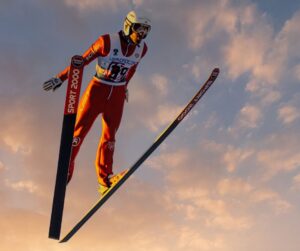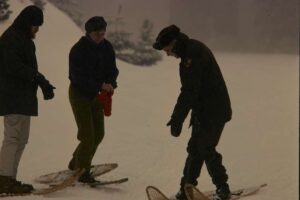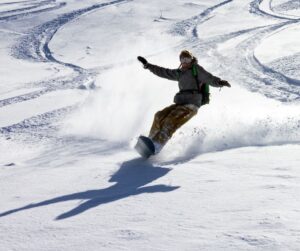Pushing Boundaries: The Evolution of Skiing and Snowboarding Techniques
Skiing and snowboarding have rich histories that spans decades. Skiing, with its roots dating back to ancient Scandinavian and Siberian cultures, was initially used as a practical means of transportation in snowy and mountainous terrain. Snowboarding, on the other hand, is a relatively young sport that emerged in the late 20th century, born from the desire to combine elements of skateboarding and surfing on the snow. Both sports have undergone significant transformations in terms of techniques and equipment over the years. In this article, we’ll delve into the historical journey of skiing and snowboarding, highlighting the key developments in each sport.
Skiing: From Ancient Beginnings to Modern Mastery
Ancient Origins
Skiing is one of the oldest forms of transportation and recreation in snowy regions. Its origins can be traced back thousands of years to the Scandinavian and Siberian regions, where it was initially used as a practical means of transportation in snowy and mountainous terrain. Early skis were made from wood and had a functional design, allowing people to glide across the snow efficiently.
Introduction of Alpine Skiing
 The transition from practical transportation to recreational sport marked a significant turning point in skiing’s evolution. Alpine skiing, characterized by the use of shorter skis, bindings, and more aggressive turns, emerged in the late 19th century. It gained popularity in the Alpine regions of Europe, where skiers began to tackle challenging descents.
The transition from practical transportation to recreational sport marked a significant turning point in skiing’s evolution. Alpine skiing, characterized by the use of shorter skis, bindings, and more aggressive turns, emerged in the late 19th century. It gained popularity in the Alpine regions of Europe, where skiers began to tackle challenging descents.
Technique Advancements
Skiing techniques continued to evolve throughout the 20th century. Notable advancements include:
Parallel Skiing: In the early 20th century, skiers primarily used the “snowplow” or “wedge” technique, where the ski tips were pointed inward to control speed. Parallel skiing, where the skis are parallel to each other, became the standard technique for downhill skiing, allowing for greater control and speed.
Carving Turns: The introduction of carving skis revolutionized skiing in the 1990s. These skis have a curved shape that enables skiers to carve precise turns by engaging the edges of the skis in the snow. Carving has become a fundamental technique for modern alpine skiing.
Freestyle and Terrain Parks: Skiing expanded beyond the groomed slopes with the rise of freestyle skiing. Skiers began to explore terrain parks, performing tricks and jumps on skis. This evolution led to the inclusion of freestyle skiing in the Winter Olympics, further popularizing the sport.
Backcountry and Powder Skiing: Adventurous skiers sought untouched snow in the backcountry, leading to the development of specialized equipment and techniques for powder skiing. Powder skis, avalanche safety gear, and avalanche education became essential for backcountry enthusiasts.

Modern Skiing
Today, skiing offers a diverse range of disciplines, from alpine and freestyle skiing to cross-country and ski touring. Modern skiing techniques continue to evolve, with a focus on precision, speed, and safety. Ski technology, including lightweight materials and advanced ski designs, allows for greater performance and versatility on the slopes.
Snowboarding: A Radical Departure from Tradition
Birth of Snowboarding
Snowboarding, in contrast to skiing, is a relatively young sport that emerged in the late 20th century. Its origins can be traced back to individuals who sought to combine elements of skateboarding and surfing on the snow. In 1965, Sherman Poppen invented the “Snurfer,” a precursor to the modern snowboard.
Early Snowboarding Techniques
The early days of snowboarding were characterized by a lack of specialized equipment and formalized techniques. Riders used rudimentary boards with no bindings or edges. Balance and control were achieved through sheer athleticism and improvisation.
Introduction of Bindings and Techniques
As snowboarding gained popularity, equipment and techniques evolved rapidly. Key developments include:
Introduction of Bindings: The addition of bindings in the 1980s allowed riders to secure their feet to the snowboard, greatly enhancing control and stability. This marked a pivotal moment in the sport’s evolution.
Freestyle Revolution: Snowboarding became known for its freestyle aspect, with riders performing tricks, spins, and grabs in terrain parks and halfpipes. Snowboarders developed a distinct style, characterized by dynamic and creative maneuvers.
Alpine Snowboarding: While freestyle snowboarding remained popular, alpine or “carving” snowboarding also emerged. This discipline focuses on precise turns and high-speed descents, similar to alpine skiing.
Halfpipe and Big Air: The inclusion of snowboarding in the Winter X Games and Winter Olympics showcased spectacular feats in the halfpipe and big air events. Riders such as Shaun White and Chloe Kim became iconic figures in the sport.
Modern Snowboarding
 Today, snowboarding continues to evolve with advances in equipment and technique. Snowboard designs have become more specialized, catering to various riding styles, including all-mountain, freestyle, and powder riding. Snowboarders have also pushed the boundaries of what’s possible with the sport, constantly inventing new tricks and maneuvers.
Today, snowboarding continues to evolve with advances in equipment and technique. Snowboard designs have become more specialized, catering to various riding styles, including all-mountain, freestyle, and powder riding. Snowboarders have also pushed the boundaries of what’s possible with the sport, constantly inventing new tricks and maneuvers.
Conclusion
The evolution of skiing and snowboarding techniques has transformed these winter sports from ancient modes of transportation and recreation into dynamic and thrilling activities enjoyed by millions worldwide. While skiing has a longer history, snowboarding’s relatively recent emergence has injected fresh energy and innovation into the world of winter sports. Both disciplines continue to evolve, offering a wide range of styles and experiences for enthusiasts of all levels. Whether you prefer the precision of carving on skis or the creativity of freestyle snowboarding, the world of snow sports has something to offer everyone, and the journey of evolution is far from over.
Featured Resorts

Killington Resort

Pico Mountain

Mammoth Mountain

Palisades Tahoe

Arapahoe Basin

Aspen Snowmass

